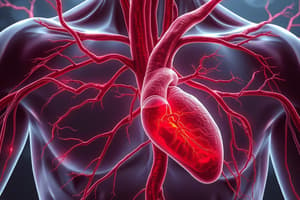Podcast
Questions and Answers
What are the three layers found in each artery's walls?
What are the three layers found in each artery's walls?
Tunica intima, tunica media, tunica adventitia
Which is the largest artery in the body?
Which is the largest artery in the body?
Aorta
What is the main function of the aorta?
What is the main function of the aorta?
Carries blood from the heart to the rest of the body
Describe the role of elastic arteries.
Describe the role of elastic arteries.
Explain the function of muscular arteries.
Explain the function of muscular arteries.
What types of cells are mainly present in the tunica media of arteries?
What types of cells are mainly present in the tunica media of arteries?
What are the two types of arteries and their main differences?
What are the two types of arteries and their main differences?
What are some common signs or symptoms of artery conditions?
What are some common signs or symptoms of artery conditions?
What role do arterioles play in the circulatory system?
What role do arterioles play in the circulatory system?
How do elastic arteries differ from muscular arteries in terms of tissue composition?
How do elastic arteries differ from muscular arteries in terms of tissue composition?
Explain the significance of arterioles in controlling blood flow and pressure.
Explain the significance of arterioles in controlling blood flow and pressure.
What percentage of resistance to blood flow in the body is managed by arterioles?
What percentage of resistance to blood flow in the body is managed by arterioles?
What is the function of arterioles in the circulatory system?
What is the function of arterioles in the circulatory system?
Describe the walls of arterioles in terms of thickness and diameter.
Describe the walls of arterioles in terms of thickness and diameter.
Why do veins have thinner walls compared to arteries?
Why do veins have thinner walls compared to arteries?
What is the primary role of venules in the circulatory system?
What is the primary role of venules in the circulatory system?
Why do arteries not require valves in their structure?
Why do arteries not require valves in their structure?
What type of blood do veins carry back to the heart?
What type of blood do veins carry back to the heart?
Flashcards are hidden until you start studying
Study Notes
Artery Structure
- The three layers of an artery's walls are tunica intima, tunica media, and tunica externa.
- The largest artery in the body is the aorta.
Aorta Function
- The main function of the aorta is to distribute oxygenated blood from the heart to the rest of the body.
Elastic Arteries
- Elastic arteries, like the aorta, are responsible for stretching and recoiling with each heartbeat to maintain blood pressure.
Muscular Arteries
- Muscular arteries, like peripheral arteries, are involved in regulating blood pressure through vasodilation and vasoconstriction.
Artery Composition
- The tunica media layer of arteries primarily consists of smooth muscle cells and elastic fibers.
Types of Arteries
- There are two types of arteries: elastic arteries (aorta and its branches) and muscular arteries (peripheral arteries).
- Elastic arteries have more elastic fibers, while muscular arteries have more smooth muscle cells.
Artery Conditions
- Common signs or symptoms of artery conditions include chest pain, high blood pressure, and numbness in the legs and arms.
Arterioles
- Arterioles play a crucial role in the circulatory system by regulating blood flow and pressure through vasodilation and vasoconstriction.
- Arterioles are responsible for 70-80% of resistance to blood flow in the body.
Arteriole Structure
- Arterioles have thicker walls and narrower diameters compared to venules.
Artery and Vein Comparison
- Arteries have thicker walls compared to veins due to higher blood pressure.
- Arteries do not require valves, unlike veins, because blood is pumped by the heart.
Venous System
- Venules play a primary role in the circulatory system by returning oxygen-depleted blood from the capillaries back to the heart.
- Veins carry oxygen-depleted blood back to the heart.
Studying That Suits You
Use AI to generate personalized quizzes and flashcards to suit your learning preferences.



